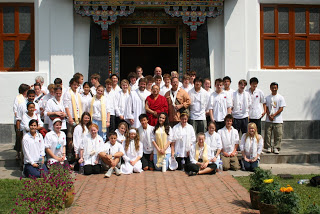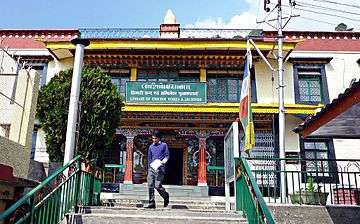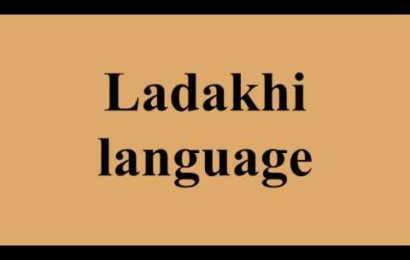Nepali and Other Languages in Nepal

The 2011 National census lists 123 Nepalese languages spoken as a mother tongue (first language) in Nepal. Most belong to the Indo-Aryan and Sino-Tibetan language families.
The official language of Nepal is Nepali, formerly called Khaskura then Gorkhali. According to the 2011 national census, the percentage of Nepali speaking people is about 44.6%. Maithili is the second largest Nepalese language and according to 2011 Census, the percentage of Maithil people is 11.57%.
Language Classification in Nepal.
Three quarters of the 123 languages native to Nepal belong to the Tibeto-Burman language family; this includes Nepalbhasa (Newa) (the original language of Kathmandu), the Limbu, Tamang, Magar, Gurung and various sunuwar, Rai languages.
However, the official and numerically most important language, Nepali, belongs to the Indo-Aryan (Indic) branch of the Indo-European family, so that Indic languages constitute 79% of the population to Tibeto-Burman’s 18%, even though most languages of both families are spoken by small numbers of people.
The small declining number of Dravidian languages are represented by Kurux, and the Munda languages of the Austroasiatic family by Santali and Mundari.
The indigenous languages of Nepal that predated the influx of Indic, Tibeto-Burman, and other families barely survive in the Kusunda language, which is nearly extinct today.
Nepal also has at several indigenous village sign languages, Jhankot Sign Language, Jumla Sign Language, and Ghandruk Sign Language, in addition to the Nepali Sign Language designed for national use.
Kathmandu Institute of Nepali Language
Kathmandu Institute of Nepali Language has been running language course for foreign visitors, volunteers and temporary residents since many years. It is conveniently location in Thamel in the heart of city urban commercial and tourist zone.
All those interested in learning Nepali, whether your needs are for a short introduction or an depth study, are invited to come alone and talk to us about your requirements.
You will benefit not only from an easier interaction with the Nepali people but also learn about Nepal’s customs, tradition and culture.
Our Approach:
We want you to really benefit from our teaching and will encourage you make the most of the class by preparing structured home work for you to reinforce your newly acquired language skilled and advance quickly.
We will measure your progress through regular written and oral testing programs.
Because we take your teaching seriously, we like to work to fixed schedules, but we know that sometimes a lesson may have to be skipped. Should this happen we will try to rearrange your class at a more suitable time.
Your Choice of course
We offer the following courses:
| 1
2 3 4 |
Very basic conversation
Basic Conversation Special Course Advance Course |
01 Week
04 Weeks 12 Weeks |
Tuition
Option as the follows:
- Individual tuition,
- Group classes for 2-4 persons,
- Group discussion.
- We can some times arrange classes at your offices
(for which there is a surcharge)
Our Programme
Classes from one week up to one year.
- Are you going to make the most of your holidays in Nepal ?
- Why not learn a little Nepali ?
- On trek or simply visiting site in the valley some spoken Nepali can make all the difference.
- We can arrange the classes at your office.
- We can provide other many facilities for the students.
- Field work conversation will be every end of the month.
- Free stationeries and some course of materials.
Teaching Materials:
We use the best reference books written by the experienced and highly recommended writers as well as our own instruction manuals.
Read details: http://ktmnepalilanguage.com
CHET-JI’S NEPALI LANGUAGE CLASSES
Coming to a country and barely speaking a word of the language can be an incredibly intimidating experience. Luckily for us, we were able to take two Nepali language classes with Chet –Ji, who proved to be knowledgeable and remarkably patient teacher- necessary qualities when your students are so unfamiliar with the language.
Chet-Ji taught us some basic Nepali phrases to get us started here, such as:
Hajur – a very useful all-purpose word meaning yes, pardon or a response to being called.
Dherai ramro or ali ali ramro – very good or a little good.
Mitho cha – It’s delicious (one of our most used phrases, given the amazing food we’ve been eating!)
As well as basic introductions:
Mero naam ___________ ho – My name is __________
Mero ghar ____________ ho – I’m from ____________
Our lessons with Chet – Ji didn’t just help us with Nepali language, they also helped us to understand Nepali culture a little better and saved us from making some embarrassing cultural faux pas. For example he taught us what items we should bargain for, such as tourist goods, clothing and souvenirs and which we should pay full price for. He also taught us about ‘Nepali Time’. Here in Nepal, time is a little more relaxed, and it’s common for people to be over an hour late without causing offence. In fact, to get annoyed with someone for being late would be more likely to cause offence.
Another important part of our Nepali lesson was learning how to pronounce some of the sounds in Nepali that were unfamiliar to us. Subtle differences in what seemed to us to be the same word completely change the meaning. One of our favourite stories Chet – Ji told us about a foreign doctor working in Nepal. After asking a patient to return in two days, he was surprised to see her back the following day carrying a pumpkin. It turns out ha had pronounced the Nepali word for the day after tomorrow wrong and instead said pumpkin!
Read details: https://www.livelingua.com/project/peace-corps/Nepali/





